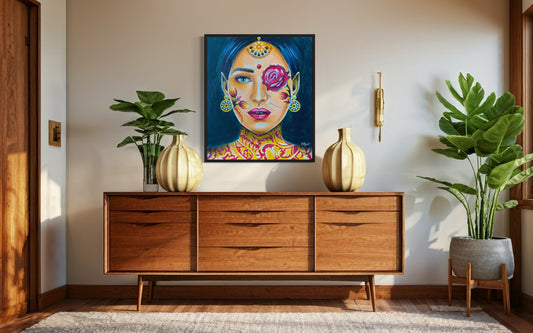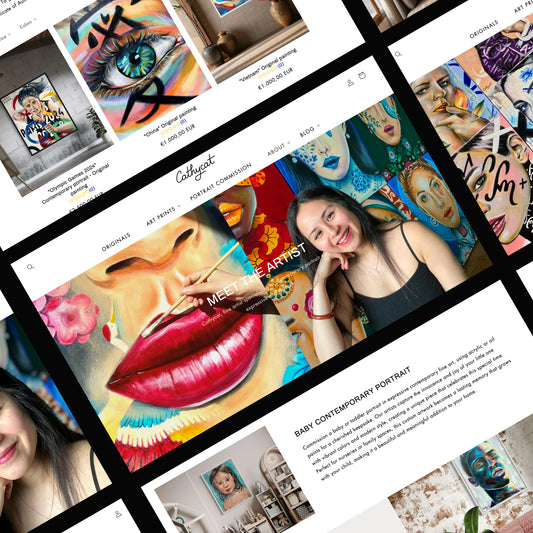
Creating a professional artist website is crucial for showcasing your work, reaching a broader audience, and generating sales. Whether you aim to build a portfolio or an e-commerce shop, having a well-designed website will help you establish your brand and grow your career. Here are 10 steps to create an effective artist website tailored to your goals.
1. Define Your Website’s Purpose
Before you start building your website, it’s important to define its purpose. Are you creating a portfolio to showcase your work to galleries and collectors, or do you want an e-commerce site to sell your paintings directly to customers? Defining your goals will guide the design and functionality of your website. For example, a portfolio site will focus on displaying your artwork in a visually appealing way, while an e-commerce site will need shopping cart functionality and secure payment options.
I personally focus on an e-commerce website to sell originals, fine arts print and canvas print contemporary expressive pop arts portraits.
2. Choose the Right Website Builder
Selecting the right website builder is essential for creating a professional site that meets your needs. Popular options include:
- Wix: Known for its flexibility and ease of use, Wix offers drag-and-drop functionality, making it ideal for artists who want complete creative control without coding knowledge.
- Squarespace: Offers beautifully designed templates that are perfect for artists looking to create a visually stunning portfolio. It’s user-friendly and has integrated e-commerce capabilities.
- Shopify: Best for artists focused on selling their work online. Shopify is a robust e-commerce platform with tools for inventory management, payment processing, and marketing.
3. Select a Template or Theme
Once you’ve chosen your website builder, the next step is to select a template or theme that reflects your artistic style. Look for clean, minimalist designs that let your artwork take center stage. Ensure that the template is mobile-responsive so that your site looks great on all devices. Many website builders offer art-specific templates, which can be a good starting point for designing your site.
4. Create a Professional Homepage
Your homepage is the first thing visitors see, so it needs to make a strong impression. Feature a selection of your best work and include a brief introduction that tells visitors who you are and what you do. Use high-quality images and a clear layout to draw people in. Include easy navigation so visitors can quickly find what they’re looking for, whether it’s your portfolio, shop, or contact information.
5. Build an Organized Portfolio
If your goal is to showcase your work, your portfolio is the most important part of your website. Organize your artwork into categories or collections to make it easy for visitors to browse. Use high-resolution images and provide detailed descriptions of each piece, including the title, medium, size, and any relevant information about the inspiration or process behind the work. Consider adding a “Sold” or “Private Collection” label to pieces that are no longer available to create a sense of demand.
6. Set Up an Online Shop
If you’re planning to sell your artwork directly from your website, setting up an online shop is essential. Choose an e-commerce platform like Shopify, or use the built-in e-commerce features in Wix or Squarespace. Ensure your shop is easy to navigate, with clear categories, product descriptions, and pricing. Enable secure payment options like PayPal, Stripe, or credit card processing. Don’t forget to include clear shipping information and return policies to build trust with buyers.
7. Create an About Page
An “About” page is where you can share your story, artistic journey, and vision. This page helps visitors connect with you on a personal level, which can be a powerful tool for building a loyal following. Include your biography, artist statement, and any awards or exhibitions you’ve participated in. Professional photos of you at work in your studio can also add a personal touch and humanize your brand.
Explore the About page with the biography of Cathycat.
8. Include a Blog
A blog is a great way to engage with your audience and improve your site’s SEO. Share behind-the-scenes insights into your creative process, discuss your inspirations, or offer tips and advice for aspiring artists. Regularly updating your blog with fresh content can help drive traffic to your site and keep visitors coming back. It’s also an opportunity to share news about upcoming exhibitions, new collections, or limited-time offers.
Explore the blog from Cathycat, offering resources for Artist guide and tips for Art collectors.
9. Optimize for SEO
Search Engine Optimization (SEO) is key to ensuring your website ranks well on search engines like Google. Use relevant keywords throughout your site, especially in your page titles, descriptions, and image alt texts. Create descriptive URLs and ensure your site is mobile-friendly. Additionally, include internal links to guide visitors through your site and improve your SEO. Regularly updating your content, especially your blog, can also boost your search engine ranking.
10. Set Up Analytics and Track Performance
Once your website is live, it’s important to track its performance. Set up Google Analytics to monitor visitor behavior, page views, and traffic sources. Understanding how visitors interact with your site will help you make informed decisions about updates and improvements. For example, if certain pages have high bounce rates, you may need to adjust the content or layout to better engage visitors. Regularly reviewing your analytics will help you optimize your site and achieve your goals.
Conclusion
Building a successful artist website involves careful planning and thoughtful design. By defining your goals, choosing the right website builder, and following these steps, you can create a professional online presence that showcases your work and helps you achieve your artistic and business objectives. Whether you’re creating a portfolio or an e-commerce site, your website is a powerful tool for connecting with your audience, growing your brand, and expanding your career as an artist.


